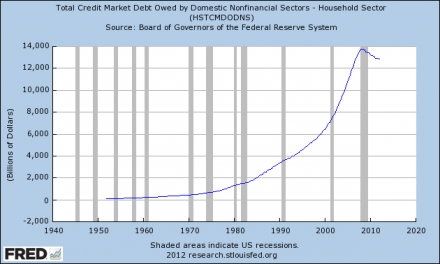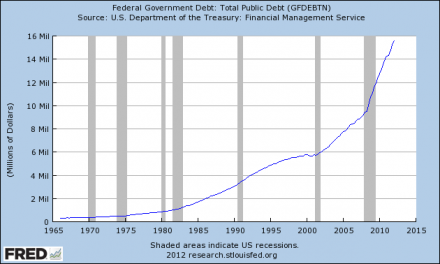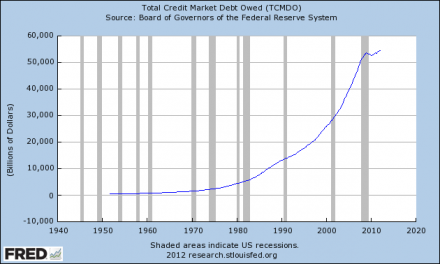 The fiscal cliff is coming! Run for the hills! There have been endless stories in the mainstream media about the “fiscal cliff” that our country is facing if the Democrats and the Republicans can’t come to some sort of an agreement. If there is no agreement, taxes will go up and government spending will be reduced by a very small amount. And yes, that would likely push the U.S. economy into another recession, although there are many that would argue that we are already in a recession right now. In any event, there is a tremendous amount of distress out there about the fact that something might interrupt the debt-fueled prosperity that we have all been enjoying. You can almost hear them now: “No! Please don’t cut government spending! Please don’t raise taxes! Please keep stealing more than 100 million dollars from our children and our grandchildren every single hour of every single day so that we can continue this economic illusion that feels so very good.” The American people want the government to give everything to everybody, but they definitely do not want to pay for it. They want a big government that showers them with government checks and government benefits, but they don’t want to cough up the ridiculous amount of money that it would take to fund such a government. So we just keep ripping off our kids and our grandkids. What we are doing to future generations is not just immoral, it is criminal. If they get the chance, someday they will look back and curse us for destroying their futures and destroying their country. So why do we continue to do this to them? Because we are greedy and selfish and we are absolutely desperate to maintain the massively overinflated standard of living that we have been enjoying. We have lived way above our means for so long that we don’t even know what “normal” is supposed to be anymore.
The fiscal cliff is coming! Run for the hills! There have been endless stories in the mainstream media about the “fiscal cliff” that our country is facing if the Democrats and the Republicans can’t come to some sort of an agreement. If there is no agreement, taxes will go up and government spending will be reduced by a very small amount. And yes, that would likely push the U.S. economy into another recession, although there are many that would argue that we are already in a recession right now. In any event, there is a tremendous amount of distress out there about the fact that something might interrupt the debt-fueled prosperity that we have all been enjoying. You can almost hear them now: “No! Please don’t cut government spending! Please don’t raise taxes! Please keep stealing more than 100 million dollars from our children and our grandchildren every single hour of every single day so that we can continue this economic illusion that feels so very good.” The American people want the government to give everything to everybody, but they definitely do not want to pay for it. They want a big government that showers them with government checks and government benefits, but they don’t want to cough up the ridiculous amount of money that it would take to fund such a government. So we just keep ripping off our kids and our grandkids. What we are doing to future generations is not just immoral, it is criminal. If they get the chance, someday they will look back and curse us for destroying their futures and destroying their country. So why do we continue to do this to them? Because we are greedy and selfish and we are absolutely desperate to maintain the massively overinflated standard of living that we have been enjoying. We have lived way above our means for so long that we don’t even know what “normal” is supposed to be anymore.
But nobody can spend far more money than they bring in forever. At some point an adjustment comes, and our adjustment is going to be exceedingly painful.
Right now, the overwhelming consensus in the United States seems to be that we should put off any economic pain for as long as possible. The American people don’t want significant cuts to government spending and they don’t want taxes to be raised to pay for the spending that we are already doing.
But if the Republicans and the Democrats don’t agree to a deal soon, we are going to see taxes raised substantially and government spending cut by a little bit. A recent CBS News article did a good job of describing exactly what this “fiscal cliff” that we are facing actually is…
There are two parts to the so-called fiscal cliff. The first is the scheduled expiration of the tax cuts enacted in 2001 and 2003 under President George W. Bush, the payroll tax holiday enacted under President Obama, and a host of other tax breaks. The second is $1.2 trillion in automatic spending cuts to defense and domestic programs that are looming due to a 2011 deal that resulted from House Republicans’ reluctance to raise the debt limit.
Now, it’s true that if lawmakers fail to work out any sort of deal, there will be severe long-term consequences for the economy: According to the Tax Policy Center, going off the “cliff” would affect 88 percent of U.S. taxpayers, with their taxes rising by an average of $3,500 a year. Many economists, as well as the nonpartisan Congressional Budget Office, say the combination of spending cuts and tax hikes that are set to take effect would tip the economy into a new recession.
Please keep in mind that the “$1.2 trillion in automatic spending cuts” is not for a single year. When you break it down, the cuts to spending would be somewhere around 100 billion dollars a year. And a lot of those “cuts” are actually spending increases that would be cancelled. So those spending cuts would not really put much of a dent in our yearly budget deficits at all.
The tax increases would be more significant. Middle class families would be paying thousands of dollars more per year in taxes. These tax increases would raise some more revenue for the federal government, but they would also do significant damage to the economy in the short-term.
Do you know what they call a combination of government spending cuts and tax increases over in Europe?
They call it “austerity”.
Nations like Greece and Spain have tried this. They cut spending and raised taxes in an attempt to reduce government budget deficits. What happens is that the spending cuts and the tax increases cause a significant economic slowdown and this causes tax revenues to come in much lower than projected. So then more spending cuts and tax hikes are necessary in order to try to get closer to balancing the budget. But then tax revenues fall even more.
In the end, both Greece and Spain still have large budget deficits and yet the economies of both nations are suffering through depression-like conditions. The unemployment rate in both nations is now over 25 percent. Just check out this chart right here to see how nightmarish austerity has been for the economies of both Greece and Spain.
So that is why everybody is freaking out about the fiscal cliff. They don’t want to go down the same road of austerity. They want to keep living in an economic fantasy land where we can borrow our way to “prosperity”.
But it is all a lie. The lines at the Apple stores, the crazed consumers on Black Friday, the restaurants teeming full with people and the government that thinks that it can take care of everyone from the cradle to the grave and yet keep taxes low. It is all a giant lie.
And no, please do not think that I am in favor of raising taxes. I most definitely am not. I believe that the government brings in more than enough money already.
Personally, I believe that we could have a system that completely eliminates income taxes and that funds the government through tariffs and various other forms of taxation. It was good enough for the Founding Fathers and it should be good enough for us. But that is a subject for another article.
Our current system has allowed us to live way beyond our means for an extended period of time, but it is only a matter of time until it all comes crashing down.
In fact, the game is already over. We have already destroyed the future. At this point it is only a matter of how long we can keep kicking the can down the road and putting off the pain.
Sadly, what we have done on a national level is simply a reflection of our “buy now, pay later” society. We have become a nation that is constantly willing to sacrifice the future in order to make the present more pleasant.
Just check out this video. We have become addicted to a prosperity that we cannot possibly pay for. But as long as someone will keep lending us the money we will continue to enjoy it.
As I have mentioned previously, the government has spent about 11 dollars for every 7 dollars of revenue that it has actually brought in while Barack Obama has been president.
We print, borrow and spend without giving any thought to what we are doing to the future of this country. We are shredding confidence in our currency and we are wrecking the greatest economic machine that the world has ever seen.
And all of our politicians and all of our “leaders” prance about as if they are the smartest generation of Americans ever, and they think that they are an “example” for the rest of the world, but if our Founding Fathers were around today they would be absolutely horrified about what they have done to the country that they built.
If you think that the economy is bad now, you just wait.
We are still in the “economic fantasy land” phase where we are enjoying a massively inflated standard of living constructed on a mountain of borrowed fiat currency. Our economy is being held up by trillions of borrowed dollars, and all of that money makes the U.S. economy appear to be far more prosperous than it actually should be.
When we have to start living closer to what our real standard of living should be things are going to get really bad.
Most Americans simply don’t understand that if the federal government went to a balanced budget tomorrow it would instantly plunge the U.S. economy into a depression.
Just look at Greece and Spain. The same thing is going to happen to us one way or another.
So enjoy this false prosperity while you still can. This is about as good as things are going to get, and from here on out it is downhill for America.

















